Archived - Icebreaker Requirements 2017-2022
Appendices
2023-2028 Client Icebreaking Requirements replaces this content.
Table of Contents
- Introduction
- Background
- Icebreaking services
- Icebreaking clients
- Industry requirements
- Planned icebreaker deployment
- Conclusion
- Appendices
Annex A - NMAB requested icebreaker deployment / Coast Guard planned deployment 2017 - 2022
Winter operations
The CCGS Louis S. St-Laurent will be utilized when a medium or heavy icebreaker is not available for winter icebreaking operations. The CCGS Amundsen will be used in the winter season for icebreaking, and will spend the summer season in the Arctic to support science projects. Icebreakers may be replaced from time to time with vessels of higher or lower capability, subject to the operational requirements and resource availability of the Coast Guard. All vessels will be multi-tasked to SAR or Aids to Navigation, as much as possible, to optimize the effectiveness of the fleet.
Arctic operations
The following dates do not include the mobilization period for the Arctic but do include transit time. The CCGS Amundsen is dedicated to Arctic Science and is not used for icebreaking operations during the summer, except in emergency situations. The CCGS Louis S. St-Laurent is dedicated to support science projects or other Government departments during the first part of the Arctic season.
General notes
Asset Availability:
- Assets will be adjusted based on conditions, while supporting industry.
- All vessel availability is dependent on Coast Guard priorities.
- Dates of availability may contain operational gaps or overlaps.
- Required maintenance and refit, as per the Vessel Maintenance Protocol, will determine availability and will vary from year to year.
- Coast Guard must take into account other requests from Other Government Departments or users of vessel services.
- Due to the age of the Fleet vessels, Coast Guard reserves the right to move vessels around as required.
- Transit time to and from the Arctic is included.
- Mobilization and de-mobilization is not included in the availability.
- Total requirements for all clients will drive Coast Guard multi-tasking abilities.
Interaction with industry:
- Coast Guard will share fleet plan for winter season when available
- Daily teleconferencing will occur with industry during the season
- Response times will be measured and reported to industry
- The Arctic and Newfoundland & Labrador Regional Marine Advisory Boards did not specify exact dates for their industry requirements. The Coast Guard Icebreaking Program has determined the user requirement dates for both regional MABs based on previous discussions with industry members.
Other:
- The Oceans Protection Plan includes the extension of the shoulder season in the Arctic to be implemented over the next 5 years based on the fleet availability but are not reflected below.
Winter season - South
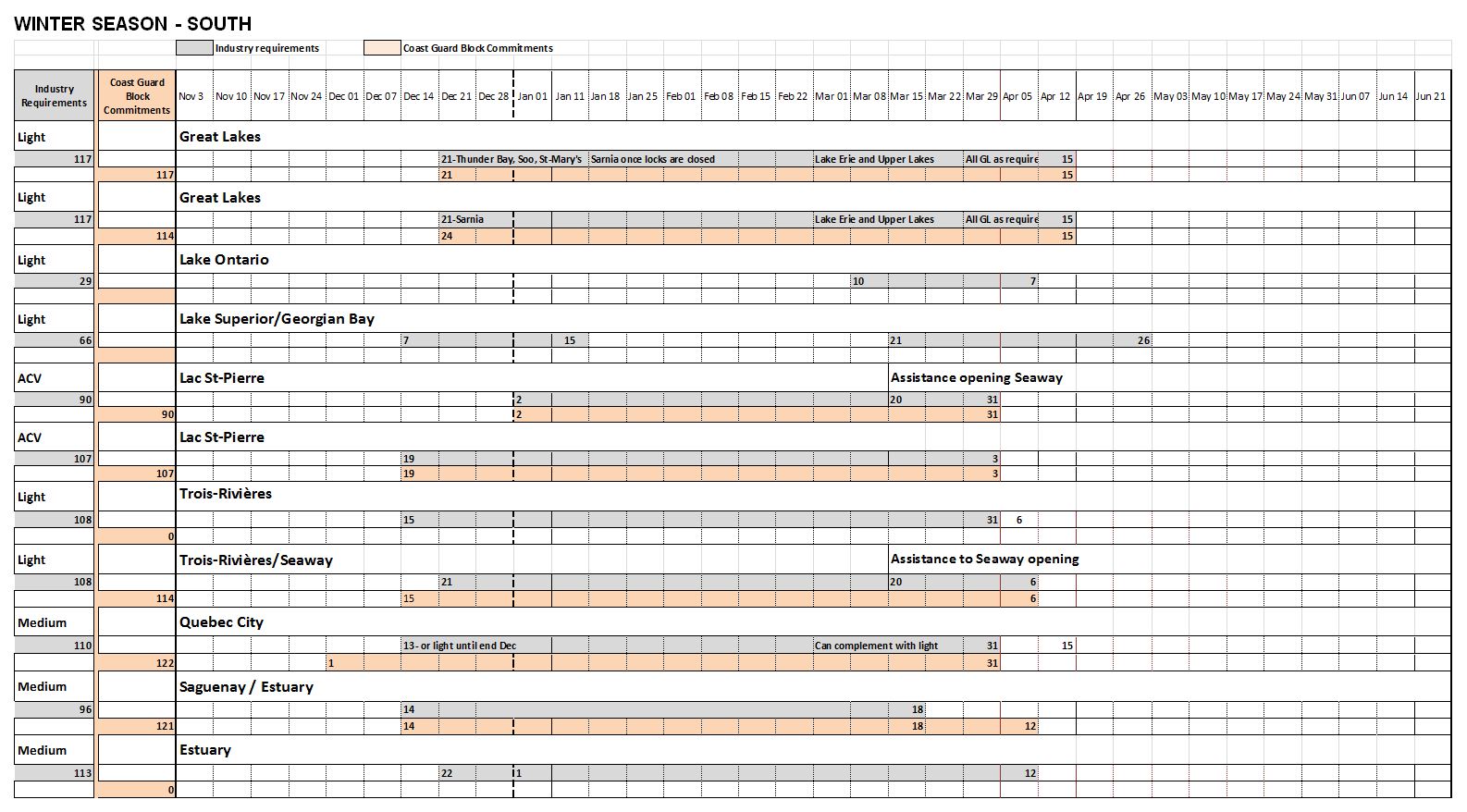
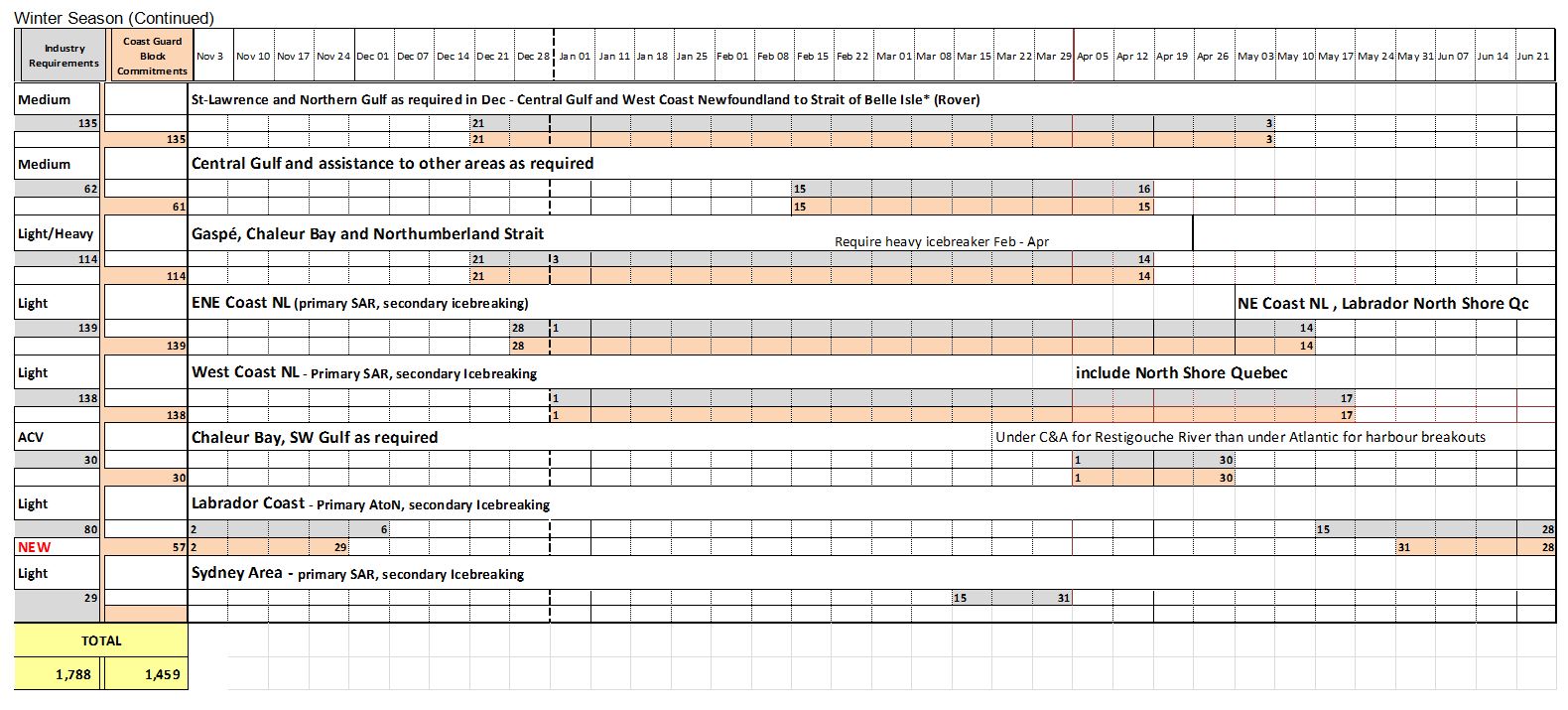
* Jan: Central Gulf, Rover from the West Coast NL, Strait of Belle Isle to NE Coast NL,as required; Feb: Central Gulf, West Coast NL to Strait of Belle Isle; March: West Coast NL to Strait Isle of Belle Isle. Assistance in the Central Gulf as required; Apr: Central Gulf, West Coast NL to Strait of Belle Isle. Assistance in the Central Gulf and North Shore Qc as required; May: Central Gulf, West Coast NL, Strait of Belle Isle, North Shore Qc.
Summer Season - Arctic
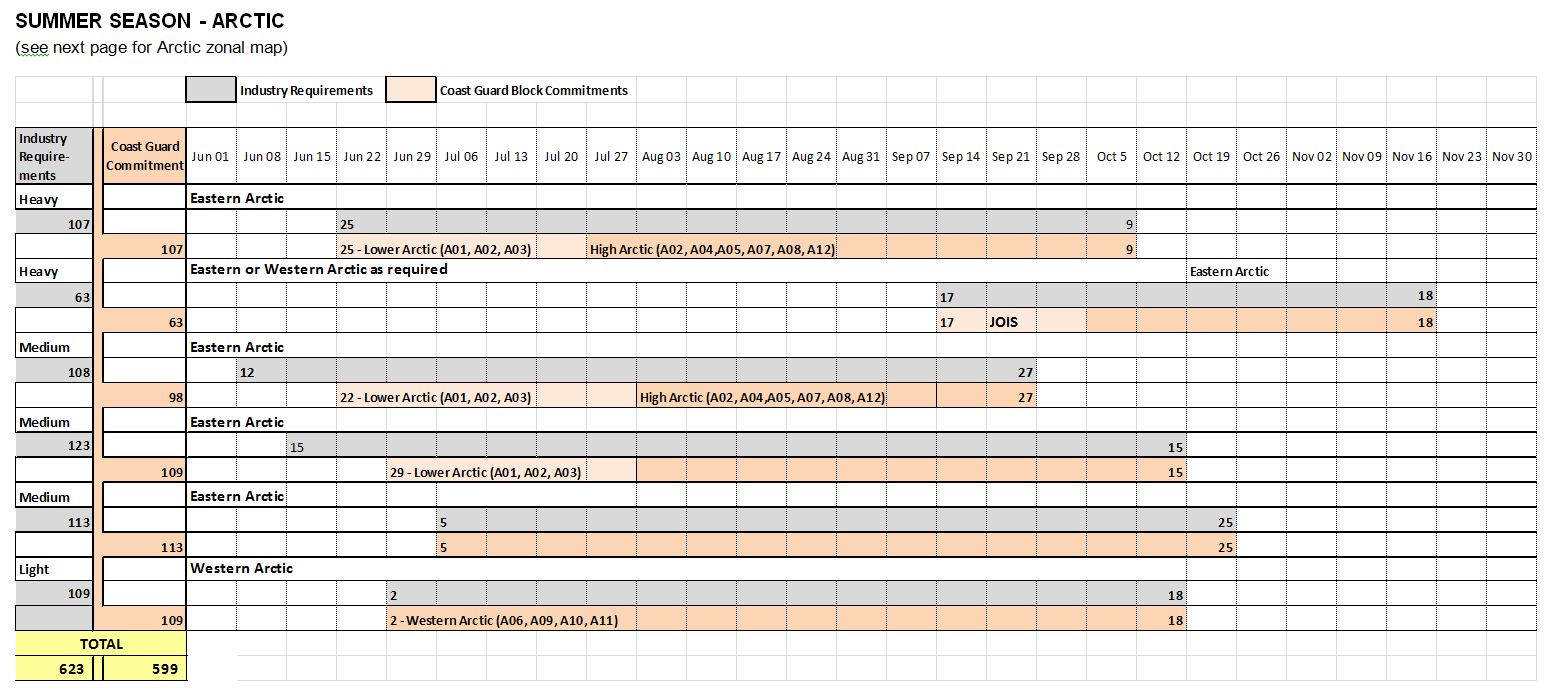
Map of Arctic Zones
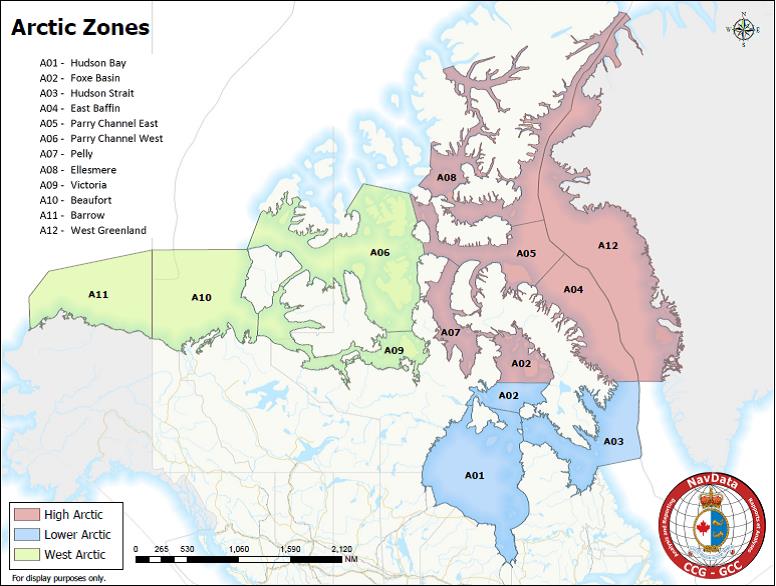
Annex B: List of Canadian Coast Guard Icebreakers
The following table is a list of icebreakers and air cushion vehicles that may be utilized for icebreaking operations. These vessels are also used to support other Coast Guard and DFO programs and undergo regular maintenance periods, and are, therefore, not always available.
At this time, with the exception of the new polar icebreaker CCGS John G. Diefenbaker, no new building plans have been approved for the replacement of these icebreakers.
| Name | Region | Type | Built | Length (m) | Draft (m) | Power (kw) |
|---|---|---|---|---|---|---|
| CCGS Louis S. St-Laurent | A | Heavy Icebreaker | 1969 | 120 | 10 | 20,142 |
| CCGS Terry Fox | A | Heavy Icebreaker | 1983 | 88 | 9 | 17,300 |
| CCGS Amundsen | C&A | Medium Icebreaker | 1979 | 98 | 7 | 10,142 |
| CCGS Des Groseilliers | C&A | Medium Icebreaker | 1982 | 98 | 7 | 10,142 |
| CCGS Henry Larsen | A | Medium Icebreaker | 1987 | 100 | 7 | 12,174 |
| CCGS Pierre Radisson | C&A | Medium Icebreaker | 1978 | 98 | 7 | 10,142 |
| CCGS Sir Wilfrid Laurier | W | HEMTV | 1986 | 83 | 6 | 5,250 |
| CCGS Edward Cornwallis | A | HEMTV | 1986 | 83 | 6 | 5,250 |
| CCGS George R. Pearkes | A | HEMTV | 1986 | 83 | 6 | 5,250 |
| CCGS Ann Harvey | A | HEMTV | 1987 | 83 | 6 | 5,250 |
| CCGS Martha L. Black | C&A | HEMTV | 1986 | 83 | 6 | 5,250 |
| CCGS Sir William Alexander | A | HEMTV | 1986 | 83 | 6 | 5,250 |
| CCGS Griffon | C∧A | HEMTV | 1970 | 71 | 5 | 2,984 |
| CCGS Samuel Risley | C&A | MEMTV | 1985 | 70 | 6 | 6,595 |
| CCGS Earl Grey | A | MEMTV | 1986 | 70 | 5 | 6,500 |
| CCGS Sipu Muin | C&A | ACV | 1998 | 28 | - | 2,818 |
| CCGS Mamilossa | C&A | ACV | 2009 | 28 | - | 3,281 |
HEMTV - High Endurance Multi-Tasked Vessels
MEMTV - Medium Endurance Multi-Tasked Vessels
ACV - Air Cushioned Vehicles
Annex C: St. Lawrence/Gulf Marine Industry Comments and Recommendations on and Icebreaker Fleet Renewal Plan
The following information is a summary from the St. Lawrence/Gulf Marine Industry Comments and Recommendations on an Icebreaker Fleet Renewal Plan, received by the Commissioner of the Canadian Coast Guard in November 2016. The Fleet Renewal Plan project office is taking this information into consideration. Additionally, a Request for Information (RFI) was issued in November, 2016, seeking information, ideas and availability of resources from industry related to gaps anticipated in icebreaking services due to the aging fleet. Coast Guard is considering the information gathered from the RFI.
Comments from Industry regarding Fleet Renewal
The Canadian marine industry has reiterated the urgent need to equip the Coast Guard with new icebreakers due to the age and state of the current fleet. The National Shipbuilding Strategy and the Canadian Coast Guard Fleet Renewal Plan does not provide proper equipment for the Coast Guard to respond to the needs of the marine industry.
Issues:
- Climate: Coast Guard planning should take into consideration worst case scenario, historical ice information and climate change.
- Shipping traffic and Economics:
- Shipping traffic is stable in the St. Lawrence/Gulf and Great Lakes, reduced in New Brunswick and parts of Newfoundland, but size of vessels is increasing, The number of Coast Guard vessel escorts is highest in the St. Lawrence/Gulf and Saguenay area rather than Atlantic. Ferries are essential for remote areas depending on shipping to get supplies. Traffic is increasing in the Arctic, including tourism activities and is spread over a large area. One or two icebreaking units cannot service the Arctic.
- Economy: Both Ontario and Quebec importers/exporters choose to transit their annual $41 billion through the Port of Montreal for European trade. All industries have reduced inventory levels to remain competitive so are more dependent on the shipping industry for stable supplies. International trade performance and transport system fluidity go hand in hand.
- Equipement:
- Vessels: Coast Guard’s two T1300 and four T1200s are needed to guarantee sustainability and reliability of the shipping lanes essential to maintain trade, ferries and supplies to remote communities. Other assets are also not reliable due to age and planned repairs/refits. The planned polar ice breaker has limited use in the St. Lawrence because of its size and no use on the Great Lakes. It will only be used in the Arctic, but not during the winter months. It does not alleviate the issue of the aging T1200 and T1300s.
- Other: Radarsat is effective and dependable for defining ice conditions. Helicopters are required for surveillance of restricted and large areas and were upgraded. AIS coverage must include all the Gulf and coastal areas.
- Operations:
- Unit Use: T1200 is most versatile and new vessels should be more powerful versions of this design. T1300 is not necessary for icebreaking services. T1100s have limited use for icebreaking but sometimes need the T1200 to assist. T1100 and T1050s are narrower so only efficient to assist ferries and fishing boats but not commercial escort. Building vessels for multitasking can weaken the effectiveness for the vessel to do anything well.
- Proposed Icebreaker Distribution:
- Great Lakes
- No change in Great Lakes. Service remains as two Coast Guard vessels (one T1100 plus one T1050) in addition to regular US icebreakers.
- St. Lawrence (River and Gulf)/Saguenay
- Shift three vessels from Atlantic (4 ferry services and 10% of traffic) to St. Lawrence River and Gulf (7 ferry services, remote communities and 90% of traffic) and avoid need for C&A to request assistance from Atlantic. Recommending two T1300, three T1200 and two T1100.
- Atlantic
- Reduce Atlantic to five icebreakers to serve Northeast coast of Newfoundland, Sydney, Prince Edward Island and the west coast of Newfoundland when required. The icebreakers would include one T1200, three T1100 and one T1050. Suggest, during winter months only, combining Halifax and St. John’s ice offices into one location in Sydney.
- Chaleur Bay - reduce commitment as historical data reflects requirements are less than commitments.
- Reduce Atlantic to five icebreakers to serve Northeast coast of Newfoundland, Sydney, Prince Edward Island and the west coast of Newfoundland when required. The icebreakers would include one T1200, three T1100 and one T1050. Suggest, during winter months only, combining Halifax and St. John’s ice offices into one location in Sydney.
- Arctic
- Traffic is increasing, is spread over and includes commercial exporting and tourism activities in addition to resupply activities.
- Great Lakes
- Governance: “The government does not perceive the Coast Guard and icebreaking services as essential for maintaining shipping efficiency and, more broadly, transport network reliability.” Industry is supportive of the Canada Transportation Act Review panel recommendation to the effect that the Canadian Coast Guard should be under the portfolio of Transport Canada. Ice breakers should be used to break ice and not be multi-tasked. Replacement of the T1200s is necessary in the near future. Five scenarios are presented to replace the T1200s. All scenarios include the requirement for short- and medium-term chartering of icebreakers while awaiting procurement and repair/build of new units. A risk assessment of each scenario is included.
- Conclusion:
It is recommended
- That the icebreaker fleet be renewed using classes equal or superior to the T1200 class.
- That Coast Guard continue to operate the icebreaker fleet.
- That it is critical that the Coast Guard charter an icebreaker temporarily to offset the shortage of units.
- That new units should replace the T1200s as soon as possible and should be based on the T1200 proven design and perhaps enhanced to a T1300 level.
- Choose a single shipbuilding site for gains in experience and lower costs.
- Consider use of long-term chartering with an option to purchase for icebreaker renewal to reduce financing risks.
- Consider use of foreign shipyard for building new T1200 considering Canadian shipyards’ restrictions of space and expertise, as well as higher costs. Stopping navigation would have much more adverse economic repercussions than the potential spinoffs generated by building these vessels in Canada.
Annex D: Historical Ice Coverage
The Canadian Ice Service (CIS) reports average ice coverage reflecting 30 years of data. Trends show a decline of ice coverage of 8% (Gulf) – 10% (East Newfoundland) per decade since 1979. However, there is still significant variability from year to year and between different areas. The maps found at the CIS website show for each week the distribution of the ice by using the median of ice concentration for each area, over the 30 year period.
East Coast
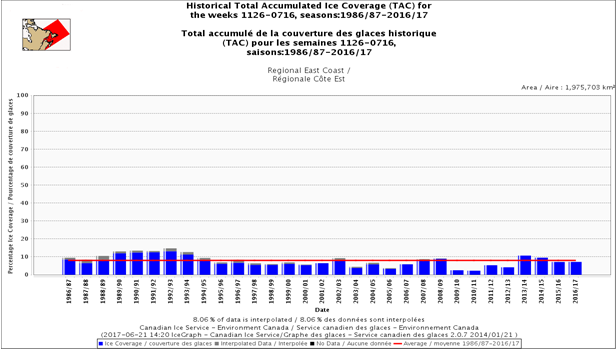
Greate Lakes
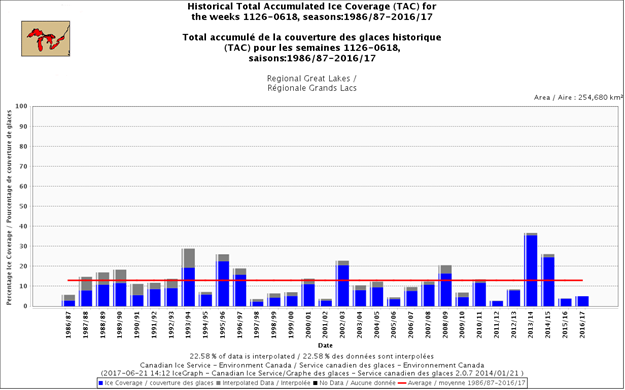
Canadian Arctic
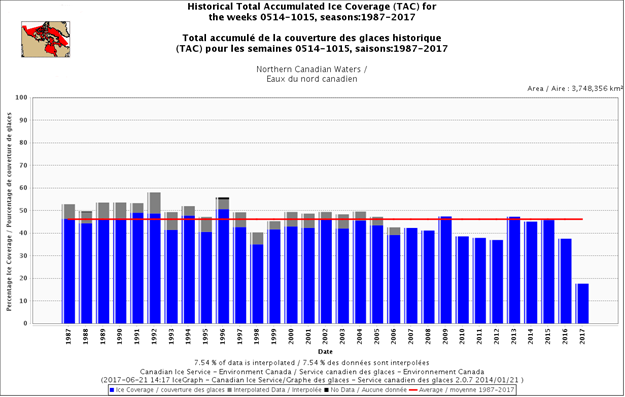
Annex E: Detailed Maritime Traffic during the ice season type of vessel
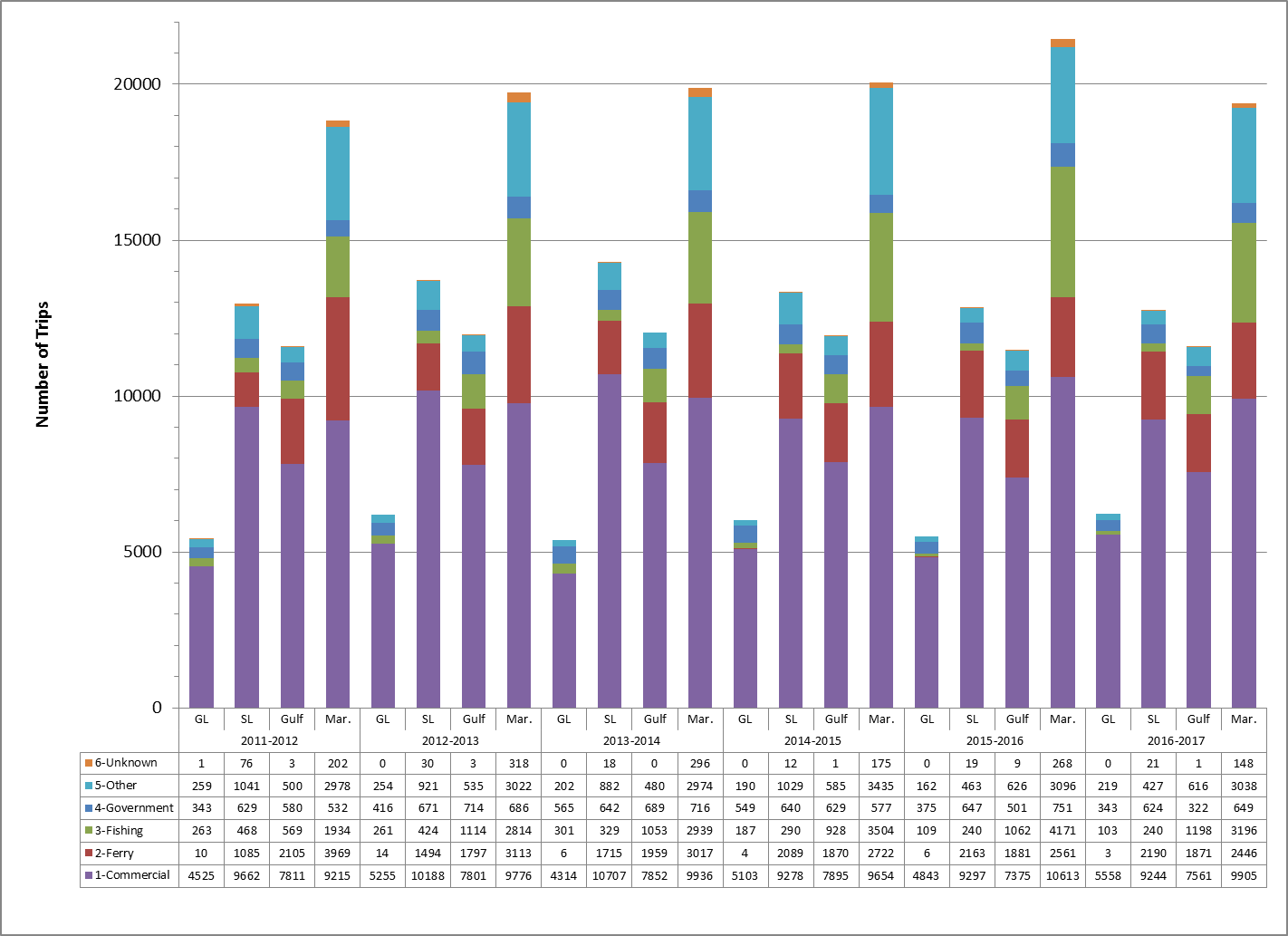
Annex F: Ice Coverage and Traffic Patterns 2011-2017
Southern Canada
Traffic density and maximum ice coverage for the 2011-2017 Winter Icebreaking Seasons (Dec - May). Higher density traffic is illustrated on an orange to red graduated scale, with red representing high density vessel traffic and orange representing low density
Southern Canada Winter Season 2011
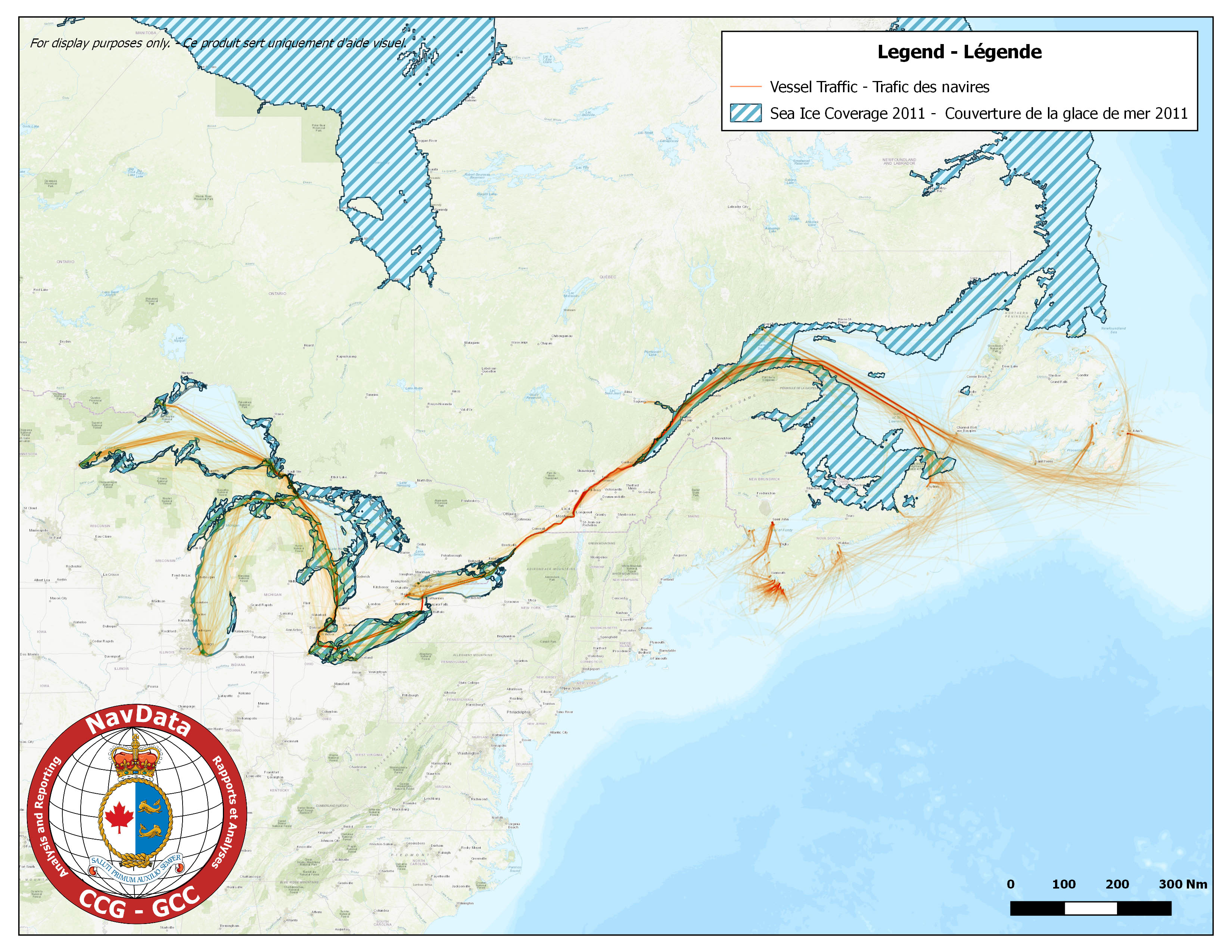
Southern Canada Winter Season 2012
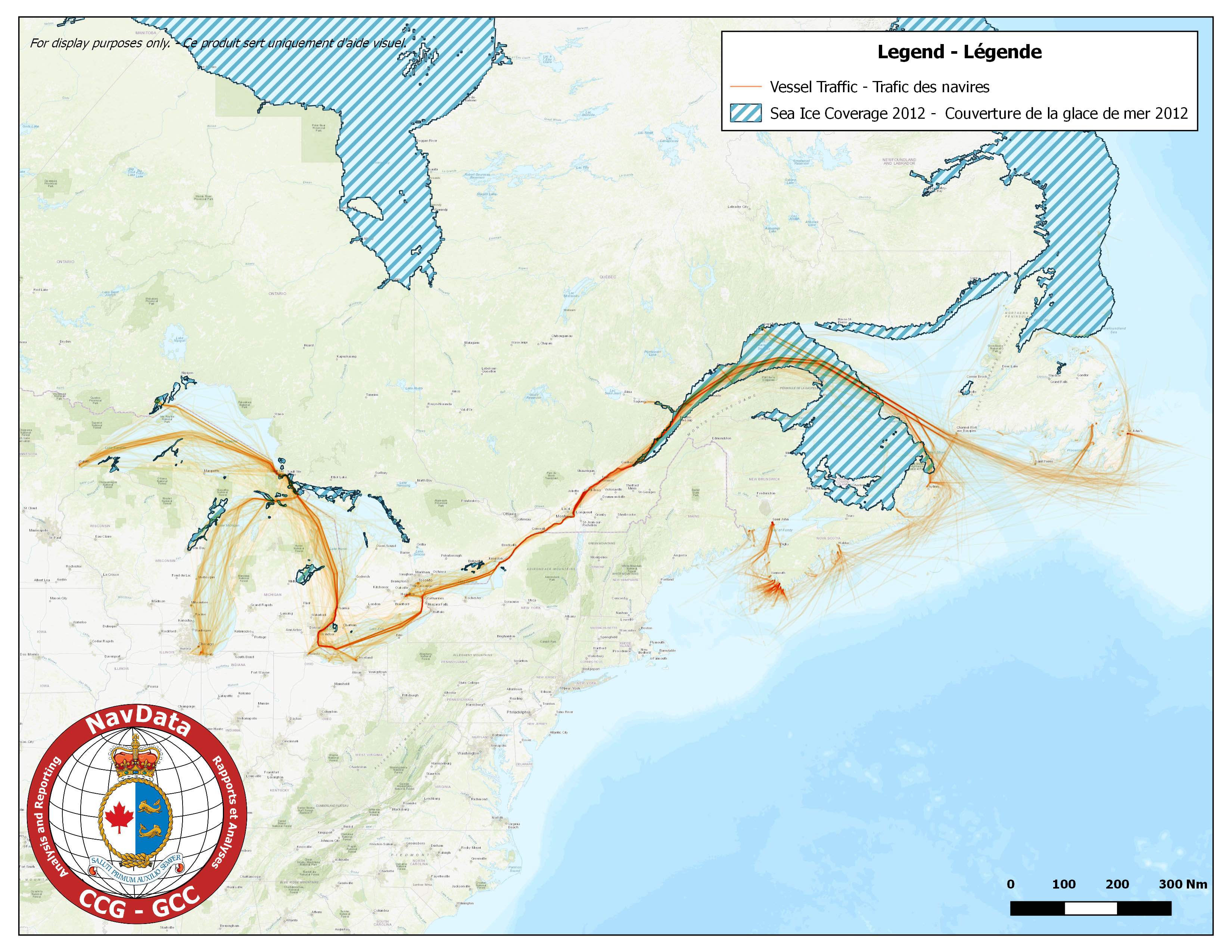
Southern Canada Winter Season 2013
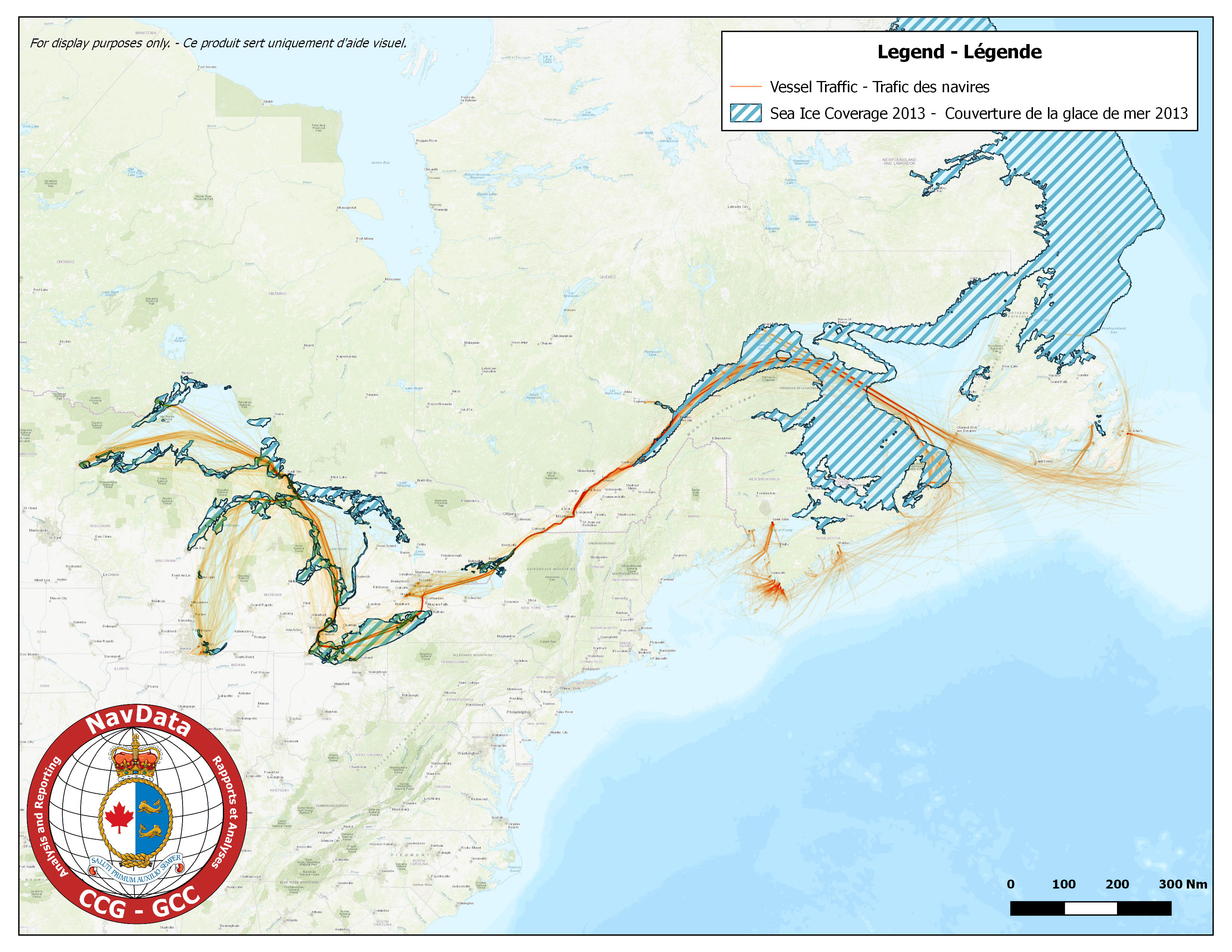
Southern Canada Winter Season 2014
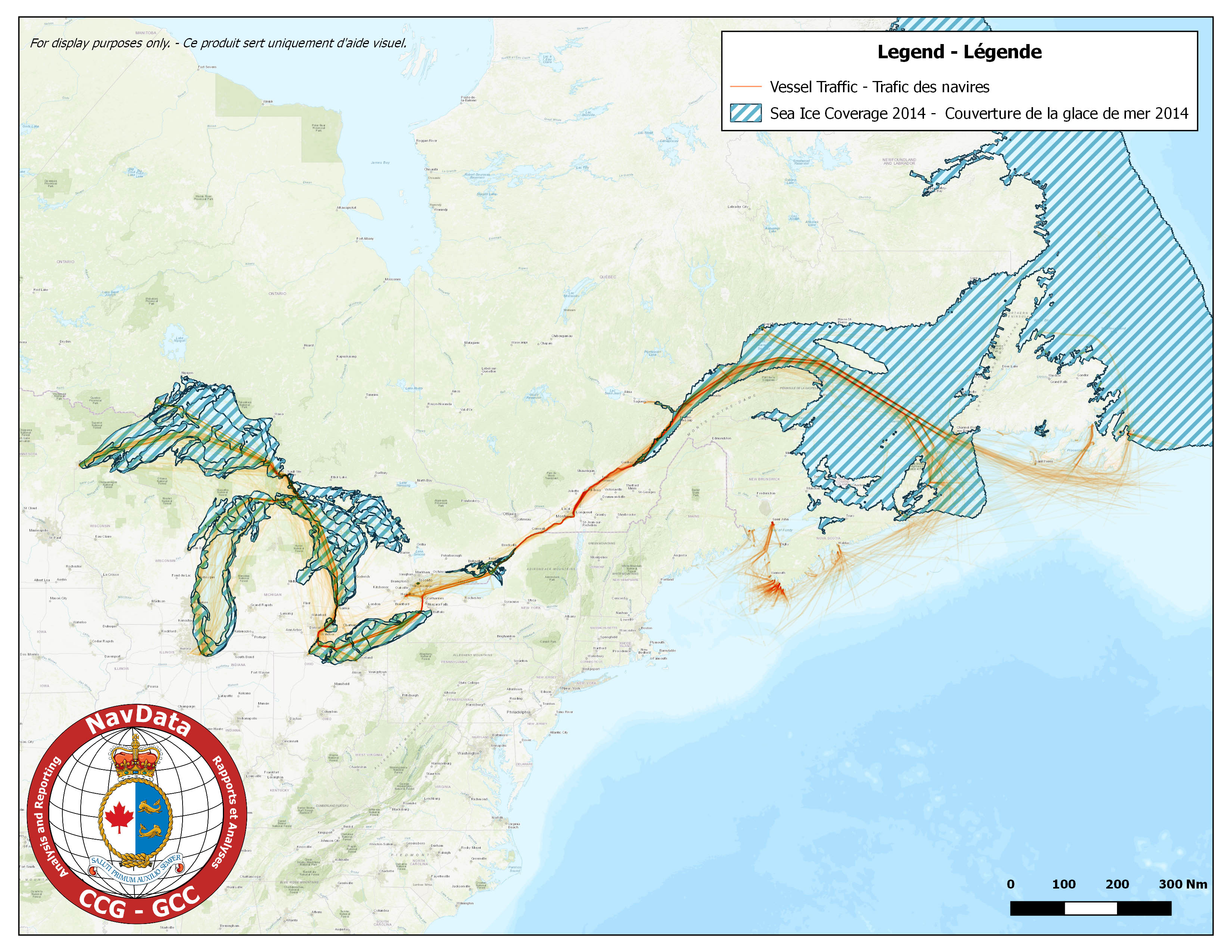
Southern Canada Winter Season 2015
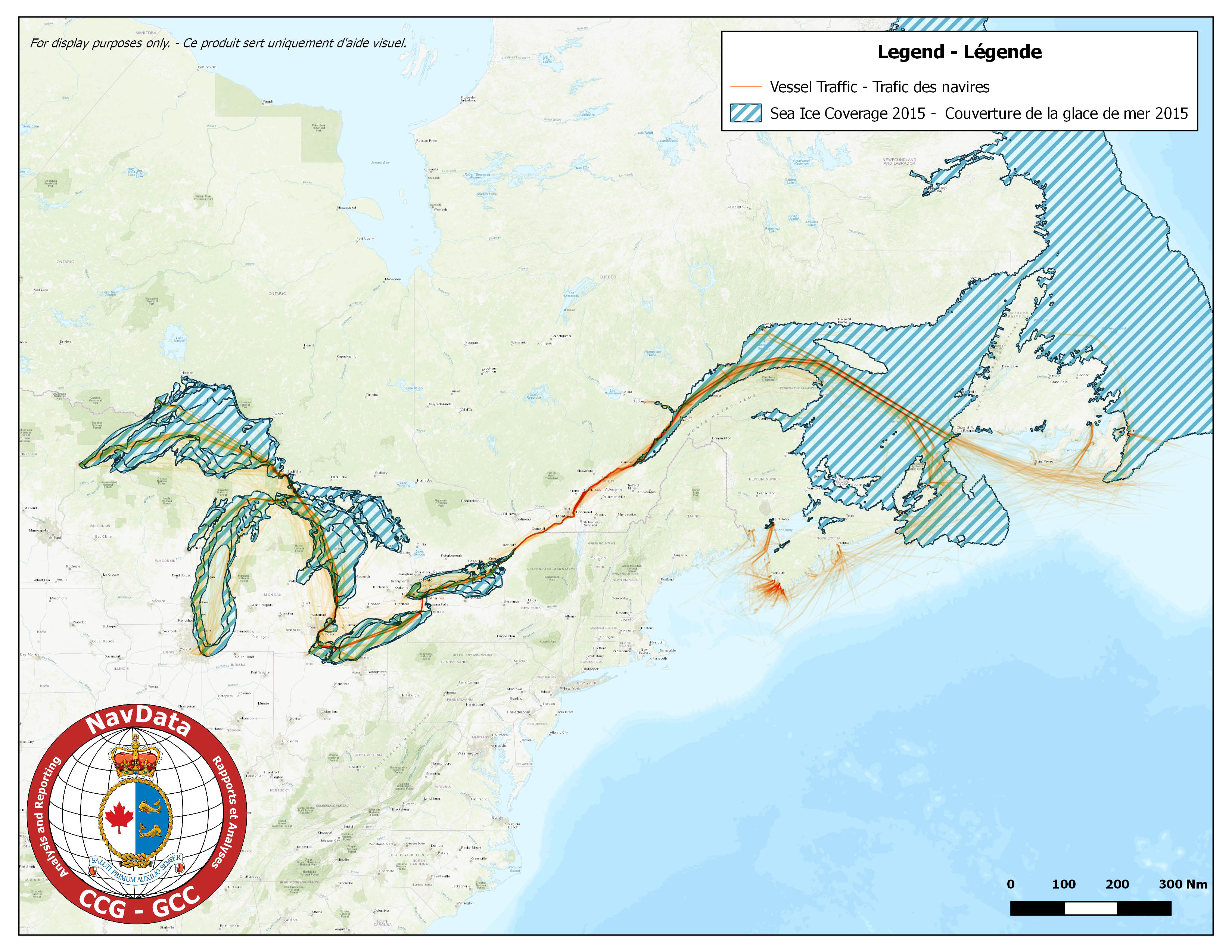
Southern Canada Winter Season 2016
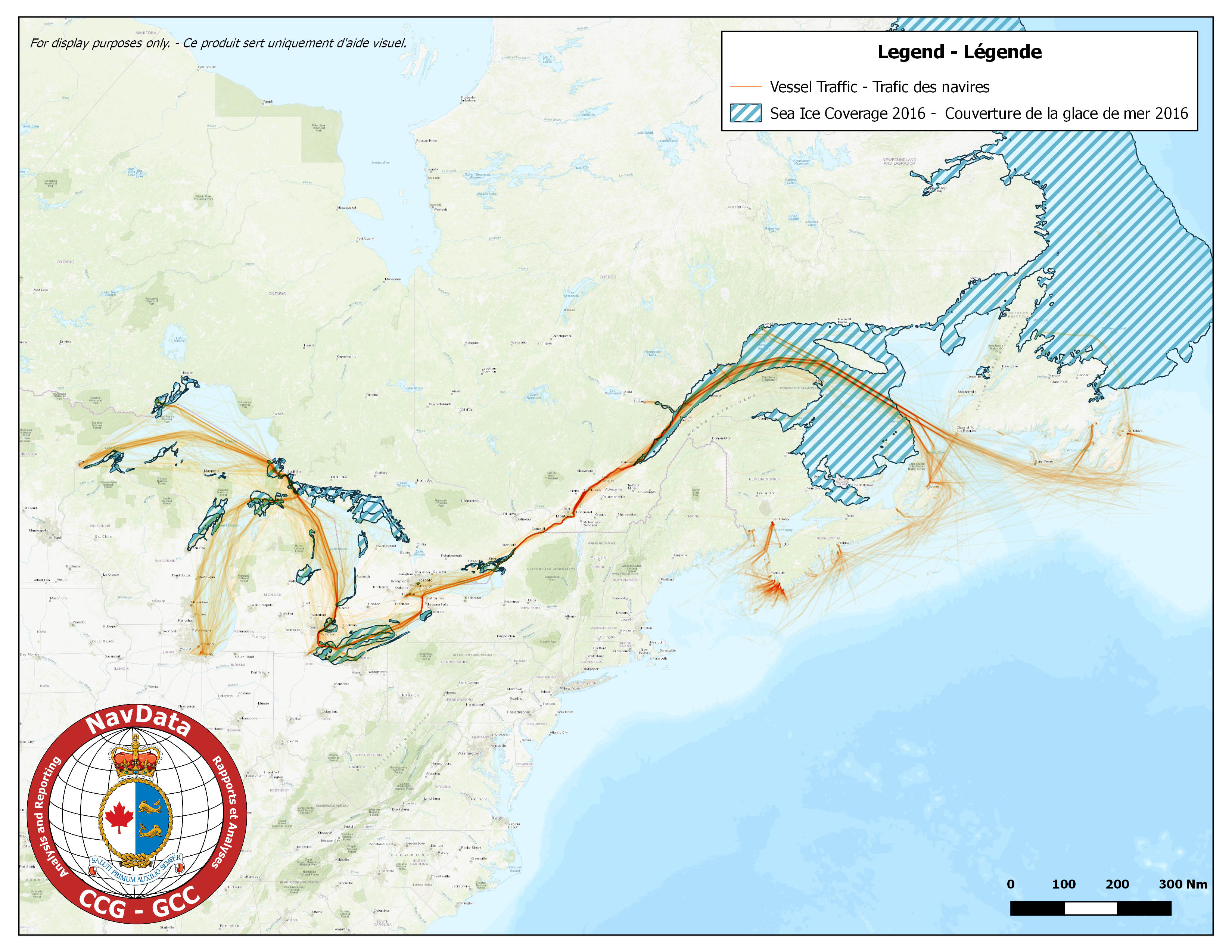
Southern Canada Winter Season 2017
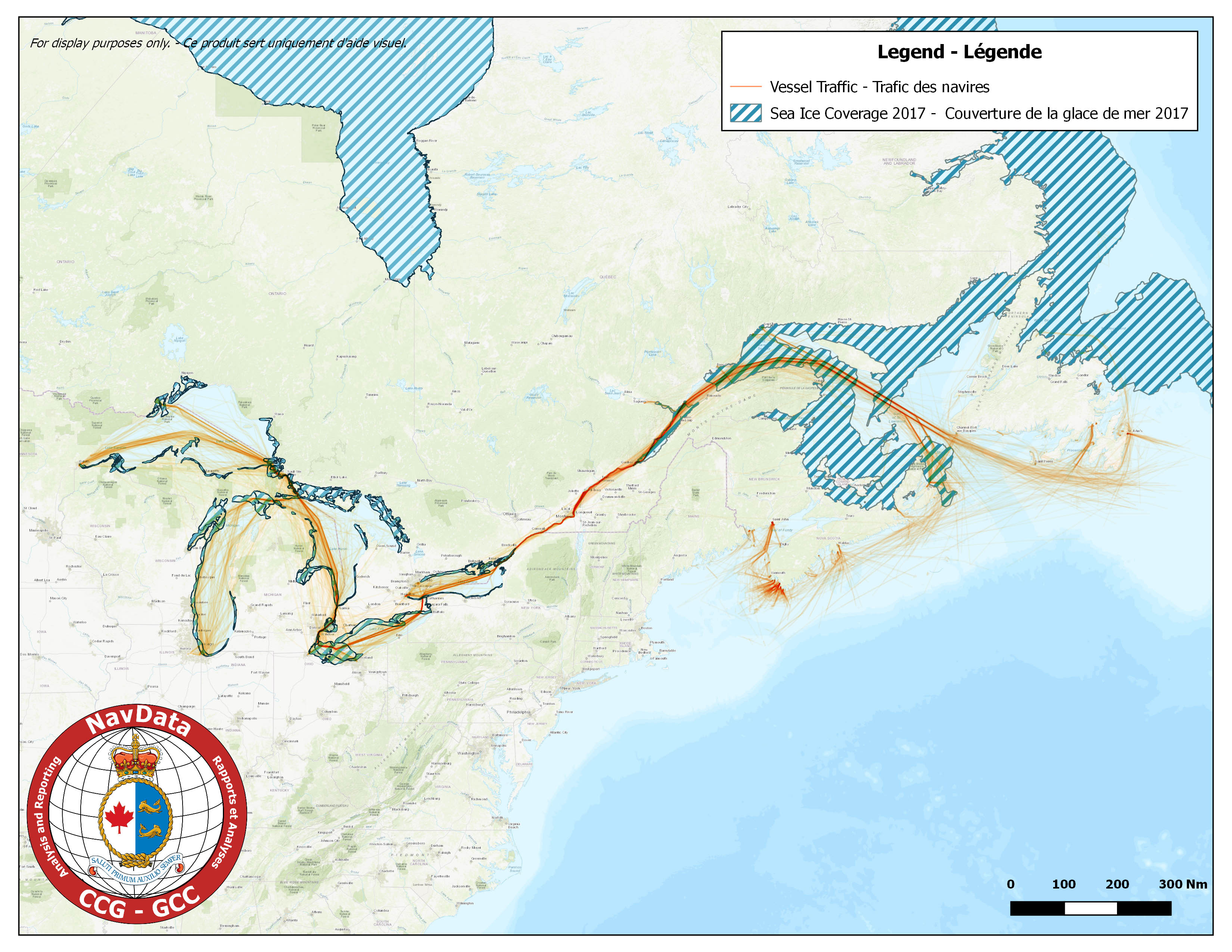
Arctic
Traffic density and average ice coverage for the 2011- 2017 Summer Icebreaking Seasons (June – Nov). Higher density traffic is illustrated on an orange to red graduated scale, with red representing high density vessel traffic and orange representing low density.
Arctic Summer 2011
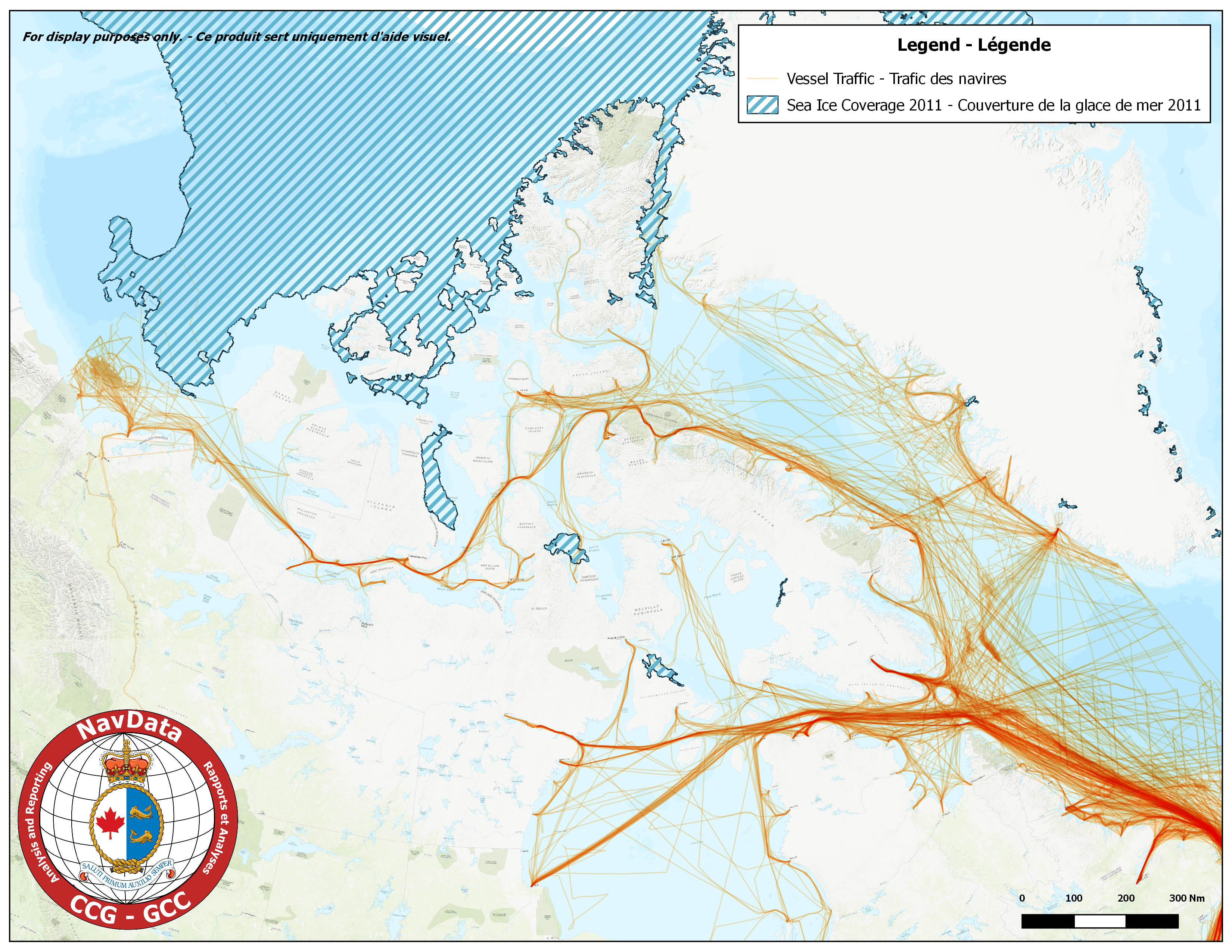
Arctic Summer 2012
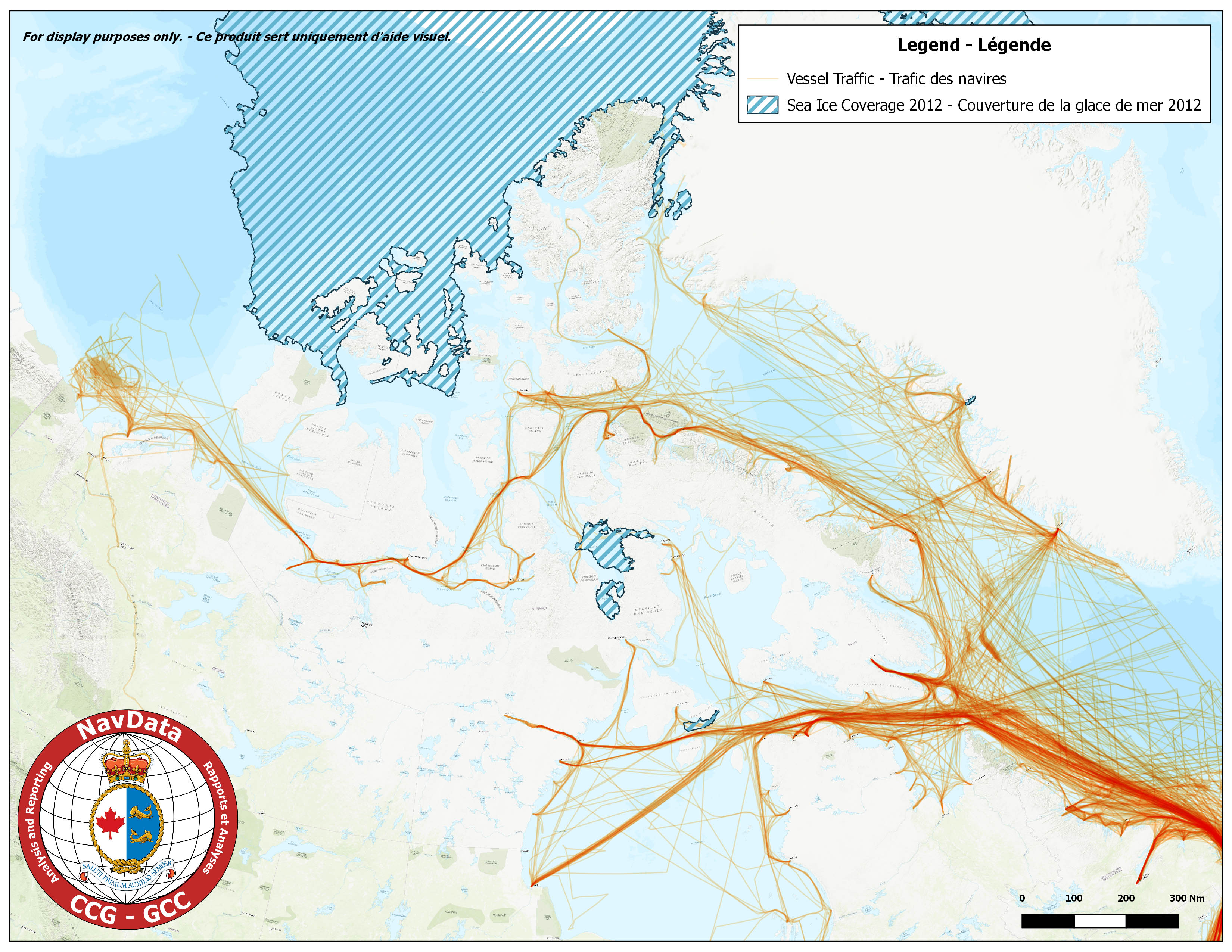
Arctic Summer 2013
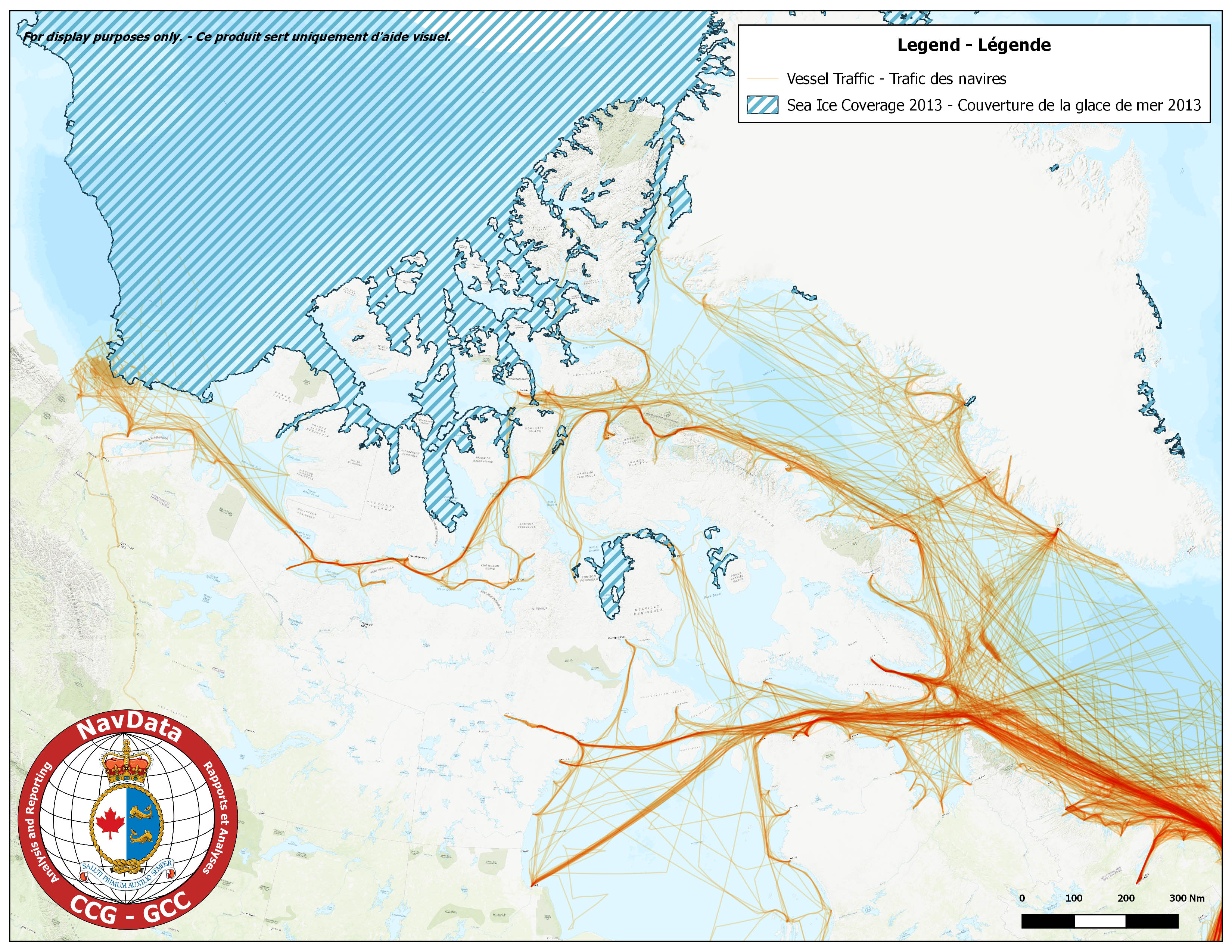
Arctic Summer 2014
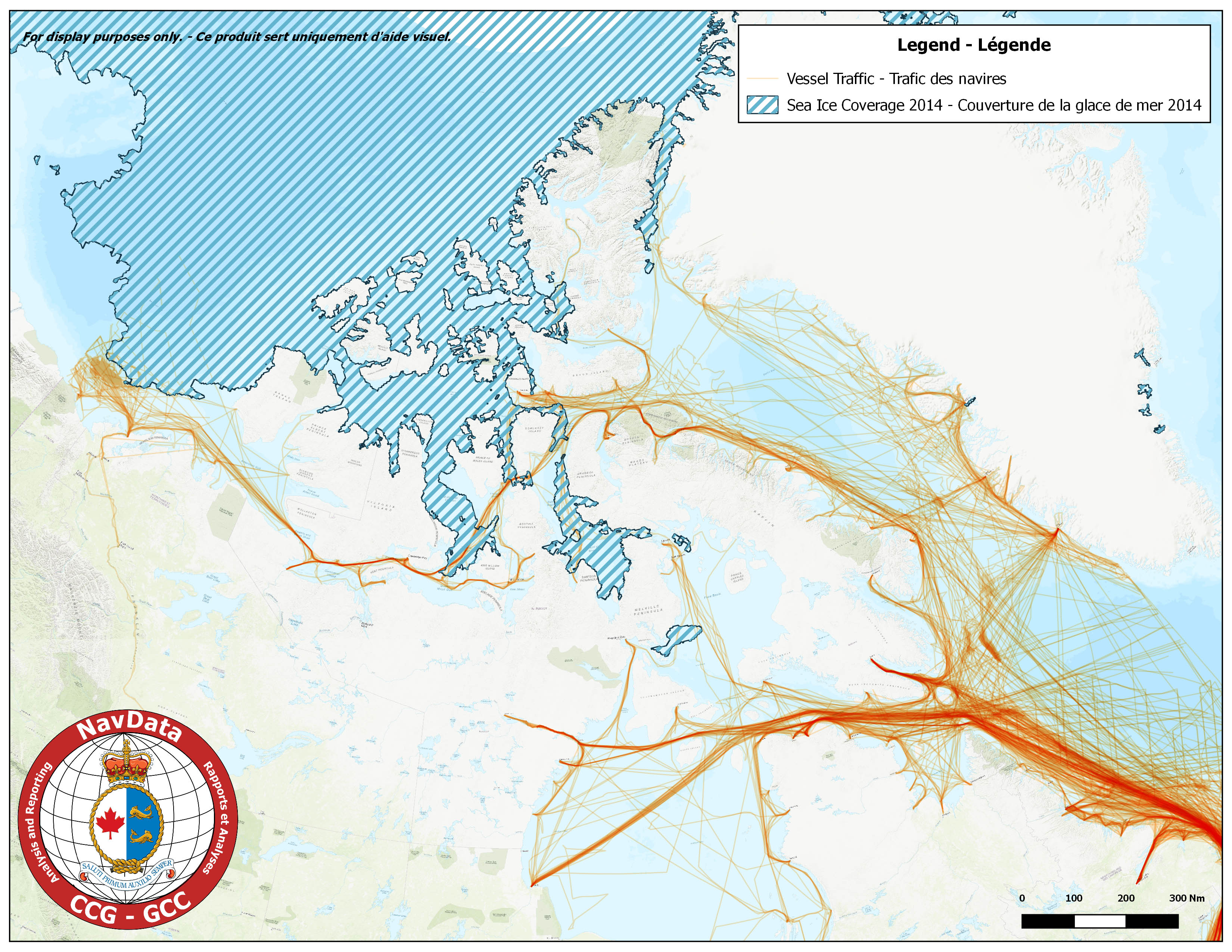
Arctic Summer 2015
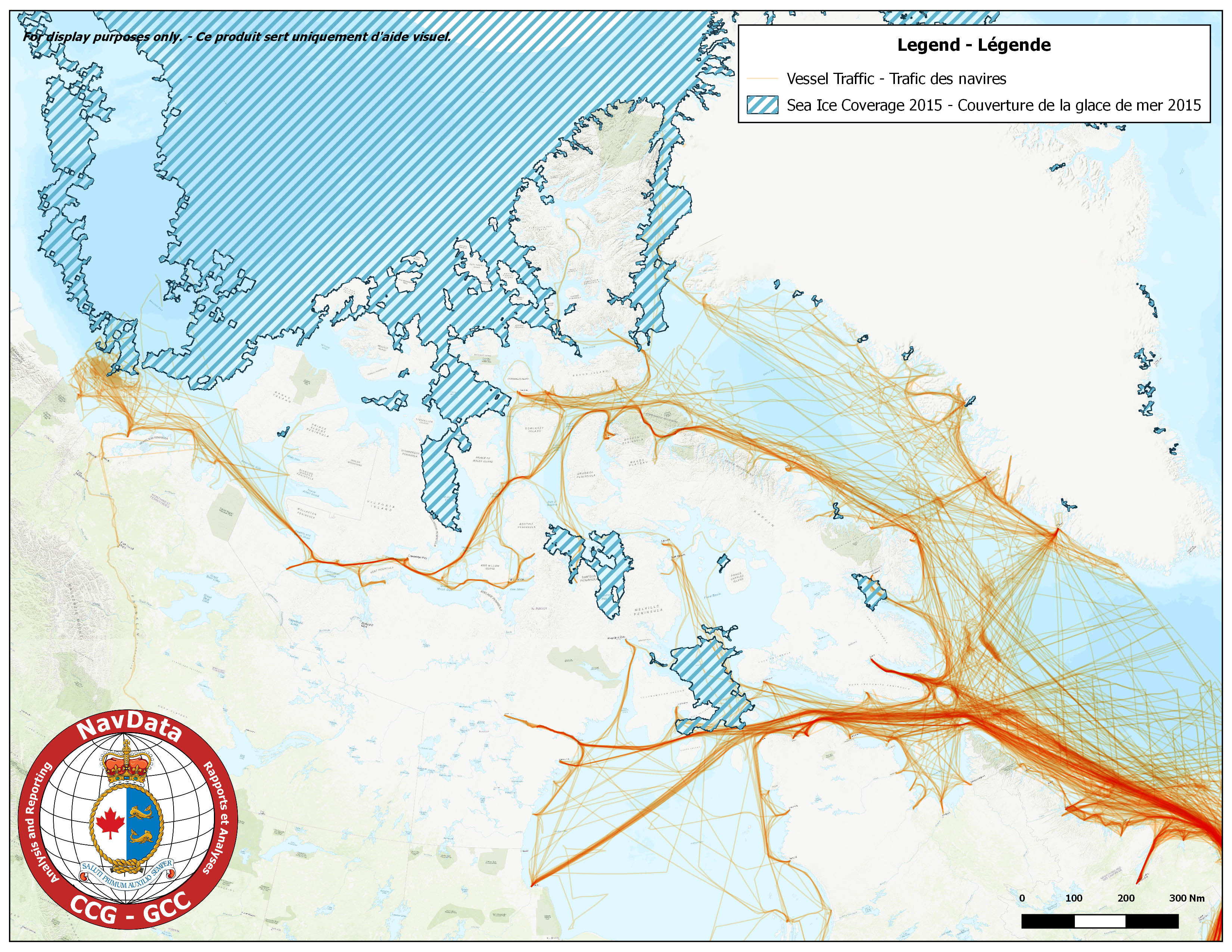
Arctic Summer 2016
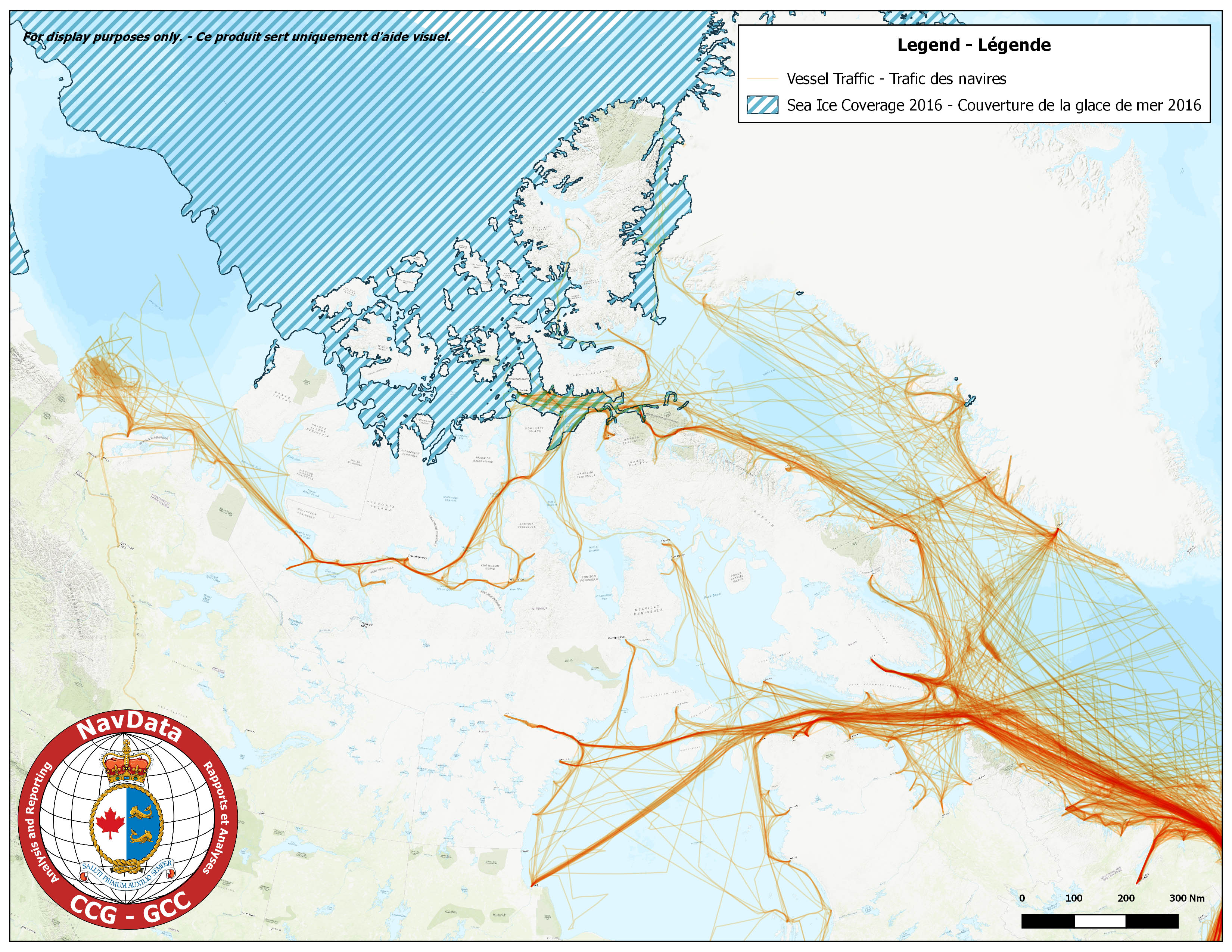
Arctic Summer 2017
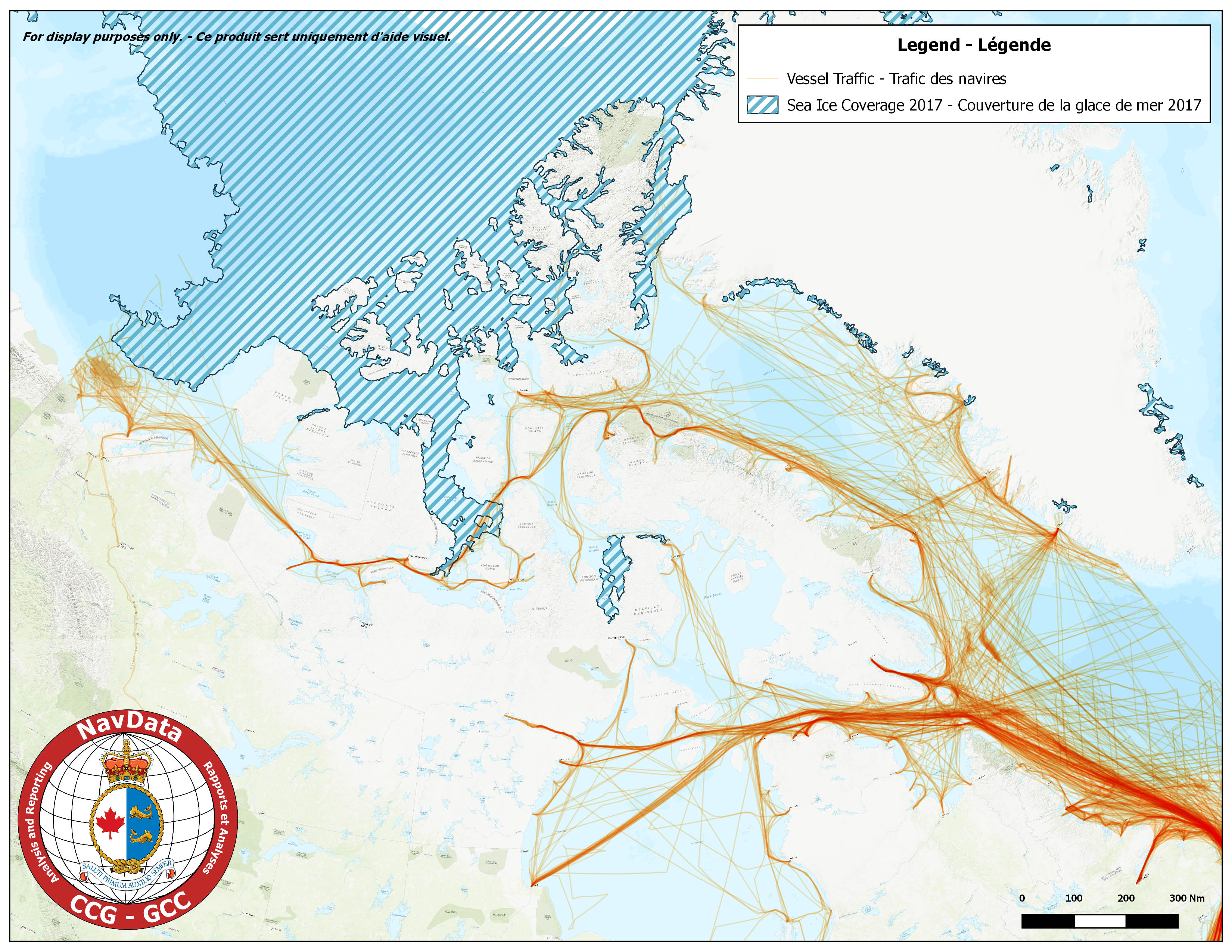
- Date modified: